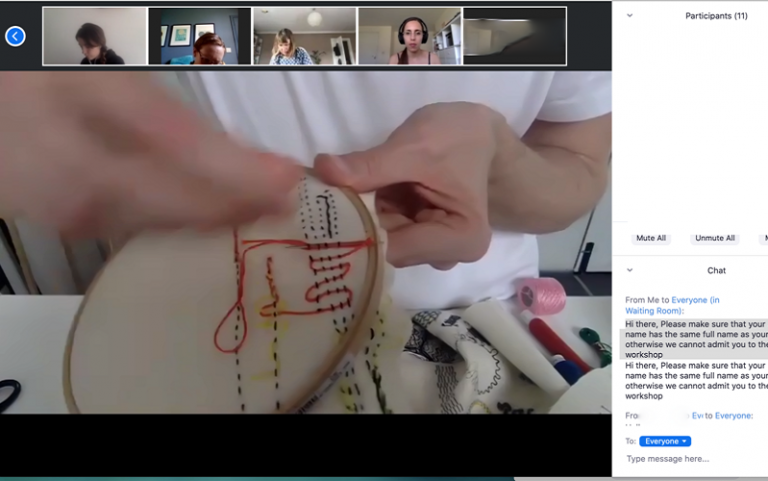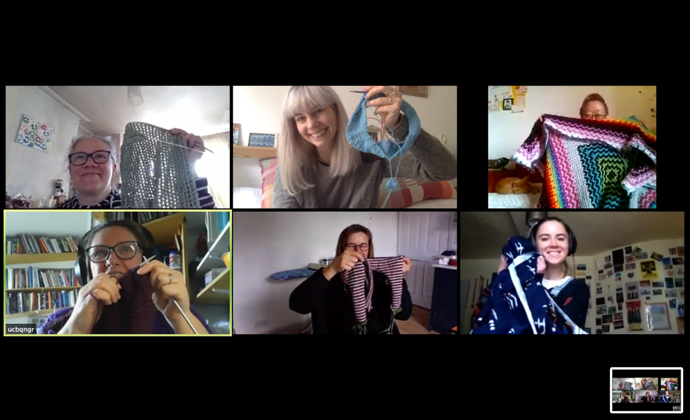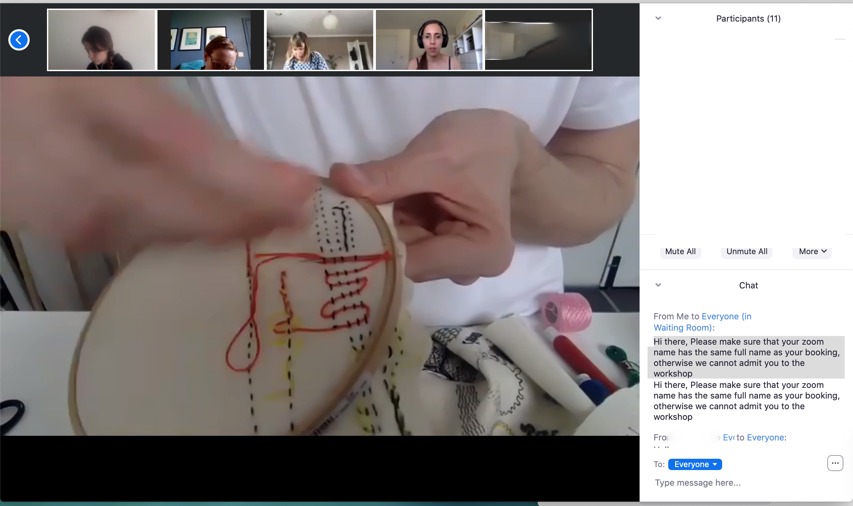Running practical teaching sessions remotely: Institute of Making case study
The Institute of Making team give an overview, and pros and cons of running practical consultations, workshops and masterclasses remotely during Covid-19.

3 June 2020
Zoe Laughlin, Co-Founder/Director of the Institute of Making provides a brief overview of some of the online activities that the Institute have staged during Term3, 2019/20, in the early days of COVID-19 lockdown.
Each section provides a summary of how a specific practical activity was staged online, remotely, and lists the main pros and cons of each mode of engagement.
The Institute of Making's experience may be useful if you are considering running any form of practical activity on a digital platform.
If you have any questions or would like to talk your plans through with us, the team welcome you to get in touch.
Technician consultations
The session
An online consultation session between an Institute of Making member (inducted staff or students of UCL) and the technicians of the Institute of Making to review, discuss or help in any way we can with the making project the member is undertaking, or hoping to undertake, at home.
Step-by-step breakdown
- Sessions are listed online and in our weekly emails, and bookable a week in advance.
- Upon booking a consultation session, the participant is emailed for further information about the project that they wish to discuss.
- A minimum of two technicians are then chosen from our team based on specialisms.
- Sessions tend to last for around 20-30 minutes.
Technology
Consultations take place on UCL's Microsoft Teams.
Pros:
- Having two technicians on the call at any one time ensures a diversity of input and better problem solving. It also improves the learning and camaraderie of the technical team whilst in otherwise isolated circumstances.
- It maintains something of the ‘real life’ experience of popping into the workshop to chat through a project with a technician.
- Video-calling enables close up visual inspection of projects.
- Screen-sharing is great for digital making projects.
Cons:
- Can’t replace physically showing and sharing the non-verbal elements of making and instructing on things like power tools etc.
- It is harder to risk-assess what the participant goes on to do as the informal continual monitoring present in the physical space of a staffed workshop is missing.
Community making circles
The session
We are running this type of event for a variety of making processes, but here we will concentrate on our most successful community making endeavour, our online Knitting Circle, that is run for a variety of communities; Institute of Making members, UCL staff and students who are not inducted members, as the general public. We currently have five different knitting circles meeting every week.
Step-by-step breakdown
- Sessions are listed online, featured in our weekly emails and bookable a week in advance.
- Existing participants are sent a short group email by our Events Manager every week with an early bird booking link, to foster a strong sense of community.
- One member of staff runs the meeting: logging in early; admitting people from the waiting room / lobby; making sure everyone is muted but can see and hear the host; welcoming the group; going through the video call etiquette; and then letting people go around one-by-one to introduce themselves.
- During the session, the Institute of Making staff member facilitates conversation and mutual peer-to-peer learning, often focussing on people's projects and problem-solving technical issues with the group alongside light chit-chat about homemaking (“what’s everyone got lined up for dinner?” etc). They also ensure one person does not overly dominate the chat and that everyone is included and given the opportunity to contribute.
- The chat function is also used to share ideas, tutorials, pictures and links. A record of the chat is emailed to all participants afterwards.

Technology
We used Zoom for the publicly accessible knitting circles and MS Teams used for the members only and UCL only knitting circles. (Note: MS Teams does have the functionality to invite members outside of UCL and is a UCL-supported platform, meaning ISD can provide guidance and troubleshooting if needed).
Pros:
- An intimate and close-knit community of practice develop relatively quickly.
- People with mutual interests are inspired by one another.
- The technology allows different people to meet and interact than may have been able to attend a physical event (we have participants in our public circle taking place in five different countries and three different continents).
- The informal and flexible nature of the event encourages a relaxed and proactive attitude to learning. People often bring back to the group something they looked up or found out since last time and are enthusiastic to share.
Cons:
- If people do not observe video calling etiquette, the group dynamic can be badly disrupted.
- If people have bad internet connections, this can disrupt the audio of the session (they need to be muted by the deliverer) and frustrate the participant.
Small-scale making masterclasses
The session
An in-depth teaching event, where 'master' craftspeople teach specialised making skills to 8-12 participants. Example listing: Embroidery Masterclass event, run for the public and for Institute of Making members.
Step-by-step breakdown
- Sessions are listed online, in our weekly emails, and on our social media channels.
- The sessions are bookable two weeks in advance.
- The event is planned in advance over video call. Teaching content and delivery is checked through, timelines are sketched out by the deliverer and our Events Manager, as are respective roles and responsibilities during the event.
- On the day, the deliverer and Events Manager meet early to test technologies and assess camera angles etc. Phone tripods and multiple streaming devices can be useful.
- The Events Manager (or other member of Institute of Making staff) acts as the host/master of ceremonies and AV technician, leaving the deliverer free to teach. The host role includes admitting people from the waiting room / lobby; making sure everyone is muted but can see and hear the host; welcoming the group; going through the video call etiquette; and letting people go around one-by-one to introduce themselves. The host then helps the deliverer facilitate conversation and mutual learning during the session, monitoring the chat function of the meeting, time keeping and solving connection issues if these present for participants.
- The screenshare function is used to share the deliverers' video tutorials, pictures and links where required.
- The 'spotlight' function is used to ensure that participants can watch detailed making processes up close.
- The 'spotlight' function is used to go around and discuss participants' results at the end of the session.
TIP: The Spotlight function in Zoom puts a participant as the primary active speaker for all participants. All participants will only see this speaker as the active. The same can be achieved by 'Presenting' in Blackboard Collaborate, and in MS Teams, you can guide your participants to 'Pin' the presenters video to the main section of the screen. See the guidance for hosting large meetings in Teams.

Technology
We used Zoom for the publicly accessible masterclasses and MS Teams for the members/UCL only events. (As above, MS Teams now has the functionality to invite members outside of UCL and is the UCL-supported platform).
Pros:
- The intimacy of the format enables a sense of engagement.
- The screenshare and spotlight options allow close-up and clear visual instruction while verbally explaining a process at the same time.
- The digital location allows a diverse range of participants from different locations to attend.
Cons:
- Conversation is more stilted and quieter as participants cannot read non-verbal cues as easily, or at all.
- The technology sometimes goes wrong.
Large-scale making masterclasses
The session
An open-forum masterclass where up to 100 participants are introduced to a set of specialised making skills. Example listing, our facial recognition camouflage event.
Step-by-step breakdown
- Sessions are listed online, in our weekly emails, and on our social media channels.
- The sessions are bookable two weeks in advance.
- The event is planned in advance over video call, teaching content and delivery is checked through, timelines are sketched out by the deliverer our Events Manager, as are roles and responsibilities during the event.
- On the day, the deliverer and Events Manager meet early to test technologies and assess camera angles. Phone tripods and multiple streaming devices can be useful.
- The Events Manager (or other member of Institute of Making staff) acts as the host/master of ceremonies, and AV technician, leaving the deliverer free to teaches. The host role includes admitting people from the waiting room / lobby; making sure everyone is muted but can see and hear the host; welcoming the group; going through the video call etiquette; and letting people know that the chat function can be used to ask questions and to register any technical problems.
- The deliver then takes the lead and runs the event whilst the Events Manager monitors the chat stream and selects questions.
- The screenshare function is used to share the deliverers' video tutorials, pictures and links if and when required.
- The 'spotlight' function is used to ensure that participants can watch detailed making processes up close.
- The 'spotlight' function can be used to see and discuss participants' results at the end of the session.
- It is useful to have other members of Institute of Making staff in attendance as audience members to provide feedback after the session is over.
Technology
We used Zoom video conferencing using speaker view and ‘hide all muted participants’ video function. (Note, the UCL-supported and recommended systems for this approach would be Blackboard Collaborate or MS Teams).
Pros:
- A large number of people are able to participate and have some form of engagement through the chat function if they wish.
- The screenshare and spotlight options allow close-up and clear visual instruction while verbally explaining a process at the same time.
- The digital location allows a diverse range of participants from different locations to attend.
Cons:
- The online event is too large for proper group conversation and participant feedback may be missed if the chat is very active.
- The technology sometimes goes wrong.
 Close
Close

